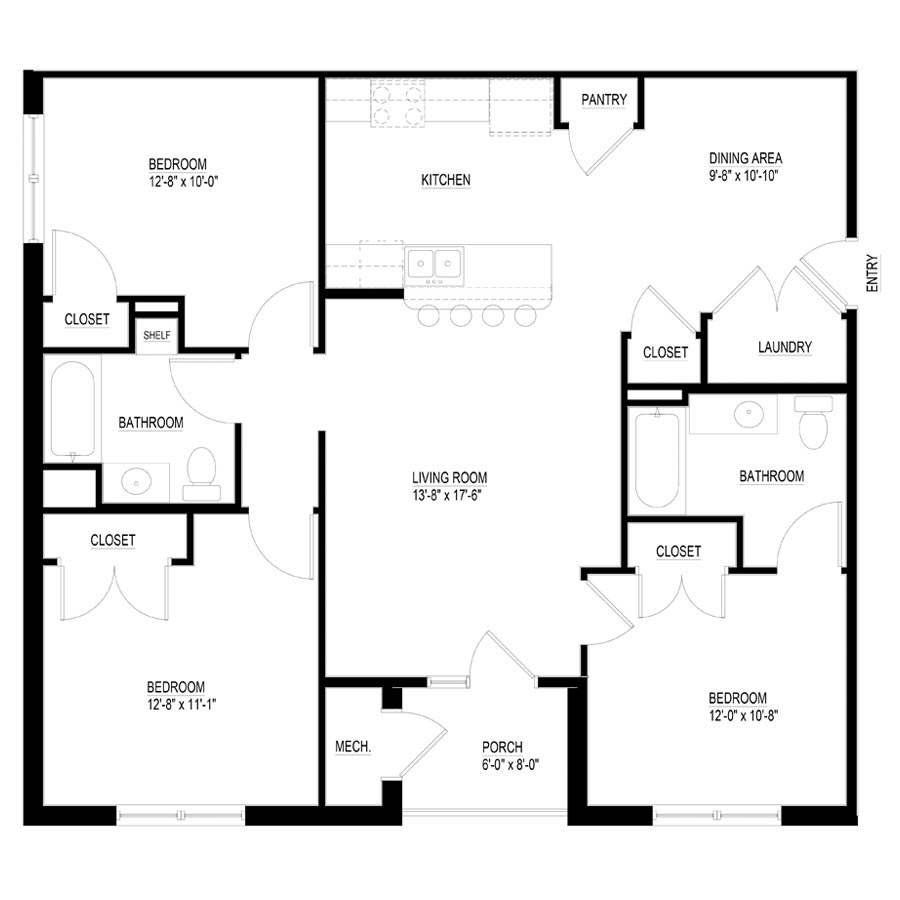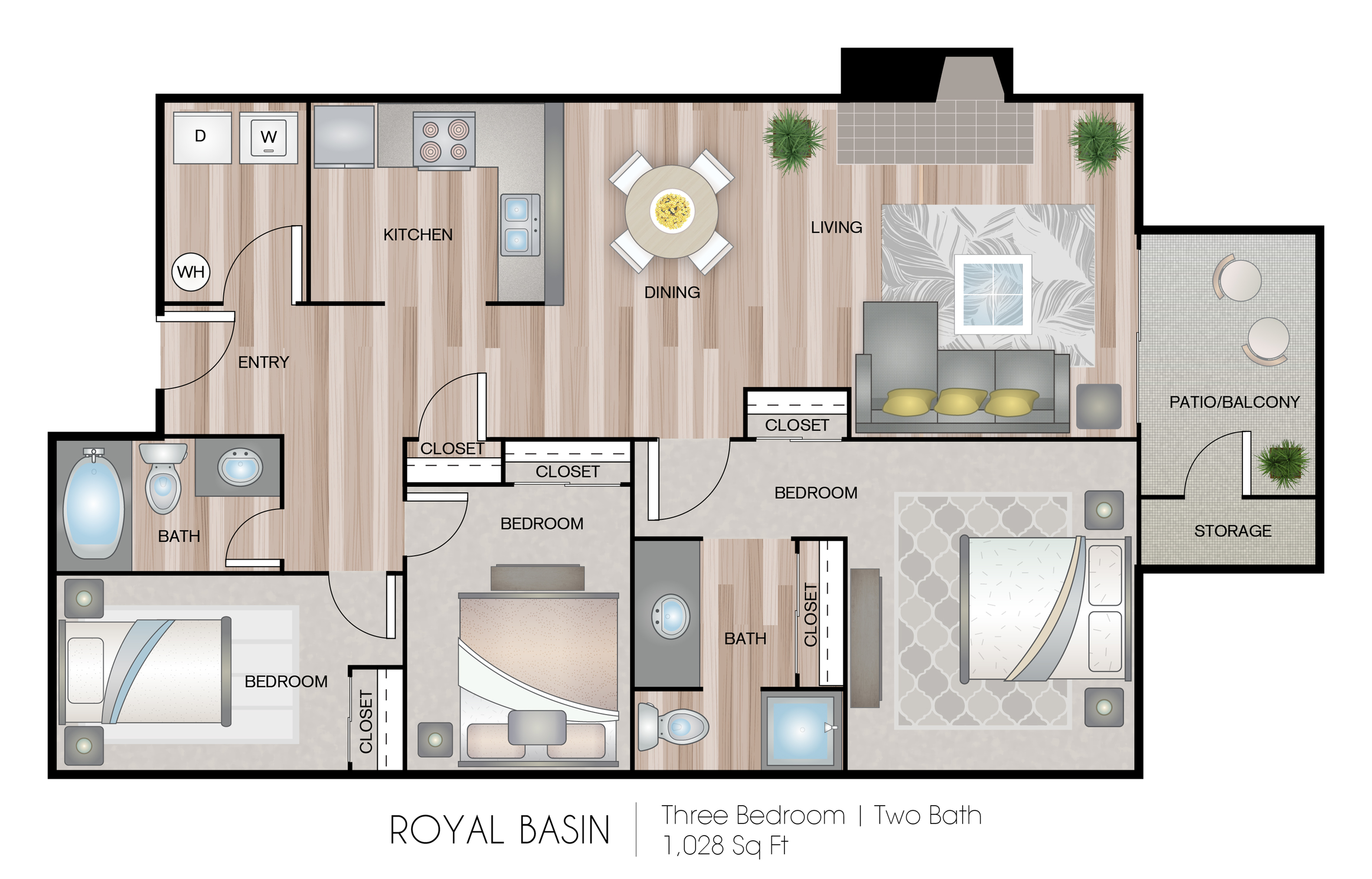Average 3 Bedroom Apartment Size Across Different Regions

The size of a three-bedroom apartment can vary significantly depending on the location. This is due to a complex interplay of factors, including the cost of living, population density, and local building codes. This exploration delves into the average size of three-bedroom apartments in major cities across the United States, examining the key factors that influence their dimensions.
Average 3 Bedroom Apartment Size in Major Cities
The average size of a three-bedroom apartment in major cities across the United States can vary considerably. This table provides a snapshot of the average size, rent, and influencing factors for three-bedroom apartments in select cities:
| City | Average Size (square feet) | Average Rent | Factors Influencing Size |
|---|---|---|---|
| New York City | 1,000 – 1,200 | $4,000 – $6,000 | High population density, limited space, high demand |
| Los Angeles | 1,200 – 1,400 | $3,500 – $5,000 | High cost of living, sprawling urban landscape |
| Chicago | 1,100 – 1,300 | $2,500 – $4,000 | Historic architecture, diverse neighborhoods |
| San Francisco | 1,000 – 1,200 | $5,000 – $7,000 | High demand, limited supply, tech industry |
| Seattle | 1,200 – 1,400 | $3,000 – $4,500 | Growing population, tech industry, waterfront location |
Factors Influencing Apartment Size
The average size of three-bedroom apartments is influenced by a combination of factors:
* Population Density: In cities with high population density, such as New York City and San Francisco, apartments tend to be smaller due to limited space and high demand.
* Cost of Living: In cities with high costs of living, such as San Francisco and Los Angeles, apartments tend to be smaller to keep rent affordable.
* Local Building Codes: Building codes can influence apartment size by setting minimum requirements for square footage per bedroom and overall apartment size.
* Economic Factors: Economic factors, such as the strength of the local economy and the availability of jobs, can also influence apartment size. In cities with strong economies and high demand for housing, apartments tend to be larger.
* Historical Factors: The historical development of a city can also influence apartment size. In cities with older housing stock, such as Chicago and Boston, apartments tend to be smaller than in newer cities.
* Neighborhood Characteristics: The characteristics of a particular neighborhood can also influence apartment size. For example, apartments in affluent neighborhoods tend to be larger than those in less affluent neighborhoods.
* Building Type: The type of building can also influence apartment size. For example, apartments in high-rise buildings tend to be smaller than those in low-rise buildings.
* Lifestyle Preferences: Lifestyle preferences can also influence apartment size. For example, families with children may prefer larger apartments than single individuals.
Factors Influencing 3 Bedroom Apartment Size

The size of a 3-bedroom apartment is influenced by a complex interplay of factors, including the number of bedrooms, the layout and floor plan, and the availability of amenities.
Impact of the Number of Bedrooms
The number of bedrooms directly influences the overall size of an apartment. More bedrooms generally mean a larger apartment, as each bedroom requires a certain minimum area for functionality. For example, a 3-bedroom apartment is likely to be larger than a 2-bedroom apartment, as it needs to accommodate additional sleeping space and potentially more storage.
Layout and Floor Plan Variations, Average 3 bedroom apartment size
The layout and floor plan of a 3-bedroom apartment significantly impact its space utilization. Here are some examples of common 3-bedroom layouts:
Open-Concept Layouts
Open-concept layouts prioritize spaciousness and flexibility by merging living, dining, and kitchen areas. This layout can make a smaller apartment feel larger but may not provide the privacy of separate rooms.
Traditional Layouts
Traditional layouts feature separate rooms for each function, offering privacy and defined spaces. However, this layout can make the apartment feel smaller and may require more furniture to define areas.
Split-Level Layouts
Split-level layouts utilize different levels to create distinct areas within the apartment. This layout can be beneficial for maximizing space, but it may require more stairs and can be challenging for those with mobility limitations.
Pros and Cons of Different Layouts
- Open-Concept Layouts: Pros: spacious, flexible, maximizes natural light. Cons: lack of privacy, can be noisy.
- Traditional Layouts: Pros: privacy, defined spaces, ideal for families. Cons: can feel smaller, requires more furniture.
- Split-Level Layouts: Pros: maximizes space, creates distinct areas. Cons: requires more stairs, can be challenging for mobility.
Influence of Amenities
The availability of amenities can also influence the average size of 3-bedroom apartments. Apartments with amenities like balconies, patios, or in-unit laundry often have a larger footprint to accommodate these features. These amenities can enhance the living experience and increase the value of the apartment.
The Importance of Apartment Size for Families

The size of an apartment plays a crucial role in accommodating the diverse needs of families. It’s not just about square footage, but how that space is configured to support the unique dynamics of each family unit.
Family Size and Composition
The number of people in a family directly influences the apartment size required. A family with young children, for example, might need more space for play areas and storage for toys. Conversely, a couple with no children might find a smaller apartment more comfortable and manageable. Families with older children who require their own space for studying or socializing will benefit from larger apartments.
Impact of Apartment Size on Family Dynamics
- Privacy: A larger apartment provides greater privacy for family members. Children can have their own bedrooms for studying or personal time, while parents can enjoy a separate space for relaxation.
- Storage Space: Families with more possessions, such as clothing, toys, and books, require ample storage space. Larger apartments typically offer more built-in storage, closets, and pantries.
- Overall Comfort: The size of an apartment significantly impacts overall comfort. Crowded living spaces can lead to stress and tension, while spacious apartments promote a more relaxed and enjoyable living environment.
Visual Representation of Apartment Layouts
Consider a 3-bedroom apartment:
Family 1: A young couple with a toddler.
– The master bedroom can double as a nursery, with a dedicated play area in the living room.
– A smaller third bedroom can be used as a home office or guest room.
– The kitchen and dining area are open-plan, providing a spacious area for family meals and activities.
Family 2: A family with two school-aged children.
– Each child has their own bedroom, providing them with privacy and space for personal belongings.
– The master bedroom offers parents a private retreat.
– The living room can be used for family gatherings and entertainment.
Family 3: A multi-generational family.
– The apartment can be configured with a separate living space for the grandparents, ensuring their privacy and comfort.
– The remaining bedrooms can accommodate the younger family members.
– The common areas should be spacious enough to facilitate gatherings and social interaction.
Average 3 bedroom apartment size – The average 3-bedroom apartment size can vary widely depending on location and building age, but you’re often looking at around 1,000 to 1,500 square feet. If you’re working with a smaller space, getting creative with your design is key.
Check out 3 bedroom condo design for some inspiring ideas on maximizing space and style. No matter the size, a well-designed 3-bedroom apartment can be a comfortable and functional home.
You know how three-bedroom apartments are usually pretty spacious? Well, even in a big space, you still want to make the most of every inch, especially in the bathroom. A blue gray bathroom vanity can really help you create a calming and stylish vibe, and that’s important in a smaller bathroom.
After all, even if your apartment is big, your bathroom probably isn’t!